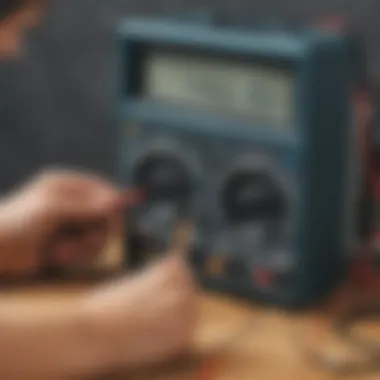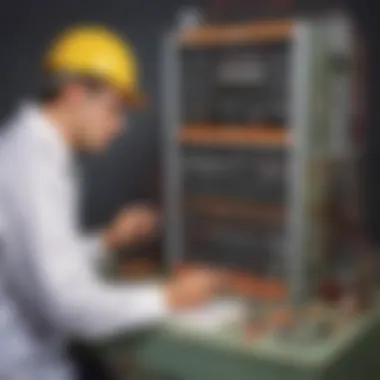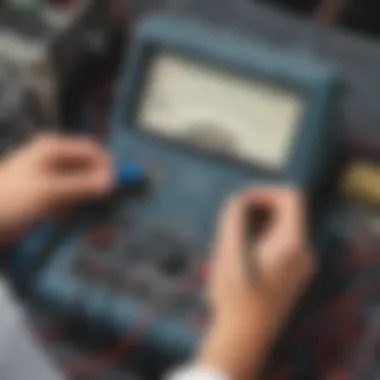Measuring DC Voltage to Ground: A Young Scientist's Guide


Intro
Welcome to the fascinating world of electricity and circuits. Understanding how to measure DC voltage to ground is a critical skill for any young scientist interested in electronics. This guide not only teaches you the concepts and techniques involved but also emphasizes safety, common applications, and how to troubleshoot effectively. Knowing how to measure voltage is essential for working with circuits, whether it be for school projects or personal experiments.
Science Fun Facts
Let's kick off with some interesting trivia related to electricity and voltage:
- Voltage Named After an Italian Physicist: Voltage is named in honor of Alessandro Volta, a pioneer in electricity.
- Electricity Travels Quickly: In copper wires, electricity travels at about 95% the speed of light!
- Air Is a Great Insulator: Normally, air does not conduct electricity. This is why we can safely use electrical devices in our homes.
By understanding these fun facts, we can appreciate the richness of science behind voltage.
Discover the Wonders of Science
Are you curious about different scientific concepts behind measuring voltage? Here’s a glimpse:
- What is Voltage?: It measures the difference in electric potential between two points. Think of it as the push that moves electric charge in a circuit.
- DC Voltage Explained: Direct current (DC) means that the flow of electric charge is in one direction only. Batteries are a common source of DC voltage.
If visuals help you learn, many educational videos exist that demonstrate voltage measurements. Websites like Britannica can provide simplified introductions to these topics.
Science Quiz Time
It’s time to check what you have learned! Below is a short quiz for you:
- What does DC stand for in voltage measurement?
a) Direct Current
b) Dynamic Charge - What unit do we use to measure voltage?
a) Amperes
b) Volts
Check your answers: 1-a, 2-b.
Quizzes are a brilliant way to reinforce learning and make it more interactive.
Science Experiment Showcase
How about trying an experiment? Here’s how to do it:
Materials Needed
- Multimeter
- Battery
- Wires with alligator clips
- Safety goggles
Step-by-Step Instructions
- Prepare your workspace: Make sure your work area is clean and free of clutter.
- Set up the multimeter: Turn on the multimeter and set it to the DC voltage setting.
- Connect the multimeter: Use the wires to connect the black lead to the ground of the circuit and the red lead to the positive terminal of the battery.
- Take the measurement: Look at the display. The number shows the DC voltage.
Safety Tips and Precautions
- Always wear safety goggles.
- Do not touch exposed wires while measuring.
Completing this experiment will provide hands-on experience, consolidating your understanding of voltage.
Understanding Voltage
Understanding DC voltage is crucial for anyone interested in electronics. It forms the backbone of most circuits and applications. Estimating the DC voltage tells us about the energy supplied and enables reliable performance in devices. This section dives into the essentials of direct current and its significance.
What is Direct Current?
Direct current, often abbreviated as DC, is a type of electrical current where the flow of electric charge is unidirectional. In simpler words, it moves steadily in one direction. Most sources of our electronic gadgets utilize DC power, meaning it’s foundational for young scientists to grasp.
A practical example of DC current is batteries. When you think about how batteries power toys or remotes, you see that these devices depend on a constant flow of energy in a single direction.
Some relevant key points are:
- Consistency: Unlike alternating current (AC), which flips direction, DC provides a steady power supply.
- Applications: Used in portable devices and vehicles, making it highly relevant.
The Concept of Voltage
Voltage is essentially the force that drives electrical current in a circuit, making it crucial to understanding electrical systems. It is measured in volts. When you measure the voltage, you understand how much potential energy is available to push charges through a circuit.


It’s vital for young scientists to know what voltage means concerning DC circuits. The voltage can influence how devices work overall. Higher voltage means power can travel farther and reach more complex machines.
To summarize, having a strong grasp of direct current and voltage forms the bedrock for future explorations in electronics and engineering.
The Importance of Ground in Circuits
Understanding the concept of ground in circuitry is critical for safe and accurate measurements. Ground serves as a reference point in electrical circuits, established for safety and stability. The ground provides a return path for electric current, thus reducing the risk of electric shock to users. In essence, without a reliable ground, electrical systems become unpredictable and hazardous.
Grounding also ensures that electronic devices operate effectively. It allows excess voltage during lightning strikes or short circuits to dissipate safely into the earth, averting potential damage to equipment.
- It prevents equipment damage by directing excess energy away from circuits.
- It enhances measurement accuracy by providing a fixed reference point.
For budding scientists, grasping the relevance of ground in measuring DC voltage is important. Not only does it impact how measurements are taken, but it also fosters safety in experimentation.
What Does Ground Mean?
In electrical terms, ground refers to a physical connection to the earth or a reference point in a circuit. It serves various roles, but one of the main purposes is acting as a safety feature. Grounding connects electrical devices to a large basin of electrons, mitigating the shock hazard in circuits. Basically, it “equalizes” the potential energy in a circuit. In many devices, you will discover a ground wire, which links internal components to a ground source, establishing stability and security.
There are two primary types of ground connections:
- Earth Ground: This type connects directly to the earth. It typically protects against faults and ensures that electrical summary can safely travel to the ground.
- Chassis Ground: Often used in electronics, this connects the metal case or housing of an appliance to ground. If a fault occurs, the current may flow safeguardably from the object rather than through any human contact.
In both cases, grounding is traditional and crucial to the safe operation of circuits.
Why Measure Voltage to Ground?
Measuring voltage to ground has a variety of practical applications that are important for new scientists and engineers:
- Non-toxic Reference: Ground provides a zero-voltage reference point for accurate measurements. Any voltage measurement taken in reference to ground simplifies understanding component behavior in various configurations.
- Safety Checking: Regular measurement helps to identify unexpected voltage levels, offering insight into possible circuit faults. A ground potential may signal a need for troubleshooting.
- Reliability in Operations: Ground serves as protection. It keeps a circuit operational and avoids excess voltage that could damage devices. Understanding this helps clear youngsters of foggy ideas about circuits.
Measuring voltage concerning ground elevates practical and educational experiences in electronic studies. It encourages a deep understanding of how current and voltage interact, enabling young scientists to innovate confidently.
Accurate measurements begin with understanding ground.
For detailed resources and a broader understanding of grounding and circuits, check links like Wikipedia for definitions and further reading or visit Britannica for authoritative articles on electronic principles.
Essential Tools for Measuring Voltage
Measuring DC voltage accurately is essential for anyone working with electronics. The right tools are the foundation for accurate voltage measurements and can significantly impact the effectiveness of any experiments conducted. Understanding these tools makes the process intuitive and safe. Each device plays a vital role, especially for young scientists eager to explore this field. In this section, we discuss three main tools: digital multimeters, analog meters, and safety equipment.
Digital Multimeters
Digital multimeters (DMMs) are the most commonly used tools for measuring voltage. They offer clear numerical readings, which many find easier to understand. DMMs provided flexibility, allowing users to measure not only voltage but also current and resistance. Many of these devices have a range of impressive features, like auto-ranging capabilities, which select the best measurement range automatically. This function is particularly useful for beginners.
Additionally, DMMs often include data logging capabilities. This can help scientists track measurements over time, especially during experiments where conditions change. Overall, using a digital multimeter can lead to faster learning on how to measure voltage accurately with fewer mistakes.
Analog Meters
Analog meters are another tool used for measuring voltage. While less common today, they still have their benefits. Unlike digital meters, these devices display measurements on a needle and dial. They can provide a more direct reading but require a bit more familiarity to interpret correctly uses the position of the needle.
Although less intuitive for newcomers, analog meters come in handy in certain situations. They often have better responses to rapid changes in voltage, making them useful in some real-time applications. For a deeper understanding of the fundamentals, including scales and needle movement, working with analog meters can be beneficial for young scientists.
Safety Equipment
Safety is paramount when measuring electrical components and voltages. A reliable pair of insulated gloves protects fingers against accidental contact with live wires. Additionally, safety goggles are advisable to shield the eyes from potential sparks or debris. Mindfulness around commons risks is absolutely essential.
Always remember, measuring voltage can be risky without safeguards. Collecting data while handling multimeters requires setting a workstation that emphasizes safety first.
Being prepared with the right tools can drastically enhance the measurement process and prevent accidents during experiments.
Together, these tools form an essential toolkit for anyone looking to master the art of DC voltage measurement. Young scientists should focus on mastering the use of digital multimeters first before exploring other tools. This will prepare them for safe, accurate, and meaningful explorations into the world of electronics.
Step-by-Step Guide to Measuring Voltage
Measuring DC voltage accurately is crucial for understanding how electronic circuits operate. This guide provides a structured approach, breaking down the process into clear steps. Each element emphasizes safety, precision, and user-friendly techniques, ensuring young scientists can engage effectively with voltage measurements. Adhering to this step-by-step format not only builds foundational knowledge but also enhances confidence in experimental practices.
Preparing the Circuit


Before taking measurements, it is important to prepare the circuit properly. Check that all connections are secure. Loose or disconnected wires can lead to faulty readings. Clear the work area of any unnecessary materials to avoid distractions. This also helps prevent accidental damage. When setting up, ensure the circuit is powered off. This reduces the risk of electric shock.
- Best practices include:
- Verifying connections.
- Ensuring the circuit is grounded.
- Double-checking that the circuit components are correctly placed.
Taking time to prepare ensures a smooth measurement process and promotes careful thinking.
Setting Up the Multimeter
Choosing and setting up the correct measuring device is pivotal for accurate readings. Digital multimeters are mostly preferred for their simplicity and clarity, but analog meters also have their place. Regardless of the type, ensure the multimeter is adjusted for DC voltage. Set the rotary switch to the appropriate range if your meter requires it. Many modern devices automatically set the range.
Pay attention to the probes:
- Black probe connects to ground.
- Red probe connects to the point in the circuit where you want the measurement.
Following these setups prepares the multimeter for accurate voltage readings.
Taking the Measurement
Conducting the measurement itself is straightforward. Position the probes according to the previous section's guideline. Carefully observe the digital display or dial on the multimeter. When taking the reading, ensure your hands do not touch any conductive parts. This keeps your measurements accurate and safe.
It is essential to remain still while taking measurements. Slight movements can lead to fluctuating results. Record the value displayed before changing connections. Also, note the attached context, like the circuit's intended function or the specific components being assessed.
Interpreting Results
Once the measurements are taken, the next step is to analyze the data. Look at the numerical value provided by the multimeter. Understanding what the value means in the context of your circuit is key. A readings too high or low can indicate issues that need to be addressed.
- Categorize your findings:
- Normal operating range: The circuit functions as intended.
- Deviation from normal: It may indicate a problem needing attention.
Take notes on any unexpected results and consider investigating further. Understanding measurements provides critical insights into circuit functionality and can help develop problem-solving skills.
Remember: Measurements can vary based on the type of circuit and components used. Develop patience and methodical thinking to cultivate your skills in electronics.
Safety Considerations
Safety is a critical aspect of measuring DC voltage, particularly for young scientists who are just starting to explore electronics. Understanding the safety protocols not only prevents accidents but also fosters a responsible approach to scientific exploration. By prioritizing safety, young learners can engage confidently with their projects without fear of harm. This section will provide essential guidance that shows the importance of safety and common hazards.
Understanding Electrical Safety
Electrical safety is the fundamental principle that protects individuals from electric shocks and burns when working with electrical circuits. A few precautions can significantly reduce risks. Some key points include:
- Always work in a dry area. Water and electricity do not mix.
- Use one hand only. When measuring or testing, especially in high voltage environments, keep one hand behind your back. This reduces the chance of completing a circuit through your body.
- Check your equipment. Regularly inspect motors, wires, and connectors for any wear and tear before starting.
- Know the tools. Understand how to correctly use devices like multimeters. A multimeter can be dangerous if used improperly.
It's critical for young scientists to learn these safety rules early. Parents and educators should provide guidance and ensure proper supervision when children are performing electrical measurements.
Common Hazards to Avoid
When working with electrical measurements, there are specific hazards that must be avoided. Simple steps can make a big difference in ensuring a safe experiment.
- Direct contact with wires. Never touch exposed wires or terminals while the circuit is live.
- Short circuits. Be sure not to let conductive materials like screwdrivers or metal clips touch together terminals or wiring junctions; this can cause sparking and damage.
- Improper voltage levels. Always make sure that the voltage your findings are relevant within the safe range for your measuring tool. Exceeding the limit can break the device or cause shocks.
- Neglecting circuit grounding. Correctly understanding what a ground wire does can help you avoid creating hazardous potentials in your setup.
To maintain integrity in experiments, always favorite precautionary safety over quick measurements. Safety equips budding young scientists to become more knowledgeable fully prepared in their quest for discovery.
By learning about safety and avoiding hazards, young scientists cultivate not just their knowledge of DC voltage measurement, but also their confidence in navigating the world of electronics in a responsible way.
Common Applications of Voltage Measurements
Measuring DC voltage is not just a technical task; it has many practical applications that young scientists can explore. Understanding these applications aids in grasping the significance of voltage measurements. Moreover, applying this knowledge can encourage students to observe their electronic environment more closely. Here, we shall look at two primary applications: testing batteries and troubleshooting circuits.
Testing Batteries
Batteries are an essential component of many electronic devices. Knowing how to measure the DC voltage in a battery is critical for ensuring devices work properly. A battery's voltage can indicate its current state. When a battery is fully charged, it usually shows a specific voltage level. Measuring this voltage can help in identifying whether it is functioning well or if it needs replacement.


Some key points to consider during battery testing include:
- Voltage Rating: Familiarize yourself with the expected voltage of a battery type, such as a 1.5-volt AA battery.
- Load Testing: In some cases, you should check the voltage under load. This means measuring the voltage while the device is on, simulating normal usage.
- Safe Measurement Practices: Always connect the multimeter probes correctly, ensuring that the red probe goes to the positive terminal and the black probe to the negative terminal.
Measuring battery voltage can determine remaining power and help prevent device failure.
By routinely measuring battery voltage, kids can develop a pastime that blends science with everyday experiences. It also sparks interest in how things work, ultimately leading to more hands-on explorations in the realm of electronics.
Troubleshooting Circuits
Another important application of DC voltage measurement is troubleshooting circuits. This process involves finding and fixing problems in electrical systems. Many devices can experience faults, leading to malfunction. Knowing how to troubleshoot helps in identifying these issues effectively.
Some useful tips for troubleshooting circuits include:
- Check Voltage Levels: Normal voltage levels indicate a properly functioning circuit. Any discrepancies often signal an issue.
- Inspect Components: All components can potentially fail. Measure the voltage before and after components like resistors and capacitors to ensure they function correctly.
- Continuity Testing: This process ensures that there are no breaks in wires or connections by checking for a return path for current flow.
Young scientists can practice troubleshooting in simple electronic projects, making it feel more engaging. Observing and resolving such issues enhances critical thinking and engineering skills, setting a foundation for future learning.
Understanding common application areas for DC voltage measurements provides young scientists with a necessary framework. It merges theoretical concepts with practical uses. Encouraging them to directly apply their knowledge fosters curiosity and innovation.
Troubleshooting Voltage Measurement Issues
Measuring DC voltage to ground is a crucial task in the field of electronics, particularly for young scientists keen to explore circuits. However, issues can sometimes arise when trying to obtain accurate readings. This section delves into troubleshooting these voltage measurement issues, providing vital information that can save time and enhance learning. Knowing how to tackle these problems makes the learning process smoother, helping young scientists develop their skills confidently.
Identifying Common Problems
When measuring voltage, it is important to be aware of various issues that may impact the results. Common problems include:
- Improper Multimeter Setup: If the multimeter is not configured correctly, it can give inaccurate potential readings.
- Loose Connections: Check whether the probes are securely connected. Loose wires can distort measurements and lead to confusion.
- Wrong Measurement Mode: Ensure the multimeter is set to the correct mode for measuring DC voltage. Mixed settings can yield errors in readings.
- Probe Contact With Circuit: The probes must make good contact with the electrical circuit for accurate measurements. Any interruptions could result in faulty interpretations.
Identifying these problems promptly can save time and prevent unnecessary frustration. Recognizing when errors occur is just as important as knowing how to take voltage measurements.
Solutions and Tips
After problems surface, it becomes necessary to consider solutions. Here are some practical solutions and helpful tips:
- Double-Check Setup: Start by ensuring the multimeter is set to the DC voltage setting. Review the user manual if you need guidance.
- Inspect Connections: Verify all connections are secure. Explore the circuitry for any loose wires that need tightening.
- Test Probes: If there’s doubt, test your multimeter with a known voltage source to see if it provides the correct reading.
- Calculate Voltage Drop: Sometimes, what happens instead of measuring straight voltage to the ground is observing voltage drop across components. Know what to expect from your circuit arrangement and measure accordingly.
- Use the Right Probes: Ensure you are using appropriate probes that fit perfectly with your multimeter and the circuit components. This small detail can make a big difference.
By applying these solutions, young scientists will develop patience and problem-solving skills critical for success in the electronics field. Adopting these practices helps them embrace challenges rather than get deterred by them.
Remember, encountering issues is a natural part of scientific exploration. Learning how to troubleshoot strengthens skills and builds confidence.
With this knowledge base, young enthusiasts can effectively navigate and address voltage measurement concerns.
Books for Young Scientists
Books are one of the most accessible resources for young learners diving into the world of electronics. They provide structured information and often feature illustrations that make complex topics more manageable. Some recommended titles include:
- Electronics for Kids by Omar M. M. Ahmed: A vibrant introduction to electronics concepts tailored for the young reader.
- Make: Electronics by Charles Platt: Offers hands-on projects that help young scientists understand real-world applications.
- The Art of Electronics by Paul Horowitz: Targets a more intermediate level but offers invaluable concepts that young enthusiasts can strive to understand.
Reading these books not only raises curiosity but also grounds theoretical concepts in real-life experiences, further boosting understanding of DC voltage.
Online Educational Platforms
The internet is home to numerous educational platforms where young learners can engage with interactive content that is tailored for various ages and levels. Some beneficial platforms include:
- Khan Academy: Offers lessons on electricity and circuits that can enrich understanding of voltage concepts.
- Coursera: Contains courses that introduce electronics to beginners. Many courses collaborate with universities and host self-paced learning.
- YouTube: Channels like EEVblog or Demos in the Lab provide practical voltage measuring tutorials and explanations.
These platforms present valuable learning opportunities. Courses and video content promote interactive learning, enabling understanding with practical applications. This can inspire young scientists to explore more
Engagement with various resources fosters a comprehensive outlook, making abstract concepts tangible for young minds.
Together, books and online platforms create a solid foundation for youth keen on electrical science. They ensure curious minds not only memorize concepts but also apply them effectively in their projects or understand voltage measurement thoroughly.
Culmination
In summary, understanding how to measure DC voltage to ground is not only fundamental but essential for those embarking on the journey of scientific exploration. This conclusion wraps together the core elements present throughout the article, emphasizing the significance of the topic. Measurement of DC voltage offers insight into the functioning of electrical circuits which forms the backbone of various technologies we use daily.
Recap of Key Points
- Understanding of DC Voltage: We explored what direct current is and its relationship with voltage. These building blocks help underpin every measurement taken in a circuit.
- Ground's Role: The importance of ground is highlighted. Ground serves as a stabilizing reference point in any circuit, allowing accurate voltage measurements.
- Tools of Measurement: Different tools such as digital multimeters and analog meters were discussed. Choosing the right equipment is key for reliable results.
- The Measurement Process: The readers learned step-by-step how to actually measure the voltage. Clear instructions help demystify the process.
- Safety Awareness: Emphasizing safety is critical in any electrical experimentation. Proper precautions protect against potential hazards.
- Practical Applications: The various applications of these measurements were explored, such as testing batteries and troubleshooting circuits.
- Troubleshooting Techniques: Problems can arise along the way. Knowing how to identify and solve these problems is immensely helpful for budding scientists.
- Resources for Deeper Insights: The resources section provided tools for young scientists seeking to learn more.
In closing, measuring direct current voltage to ground is more than just a technique — it is a key life skill for young experimenters allowing them to analyze and interact with electrical networks around them. This guide serves as a launchpad, encouraging ongoing curiosity and exploration in the exciting field of electronics.







